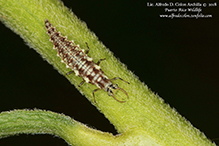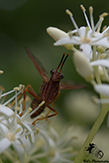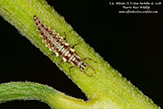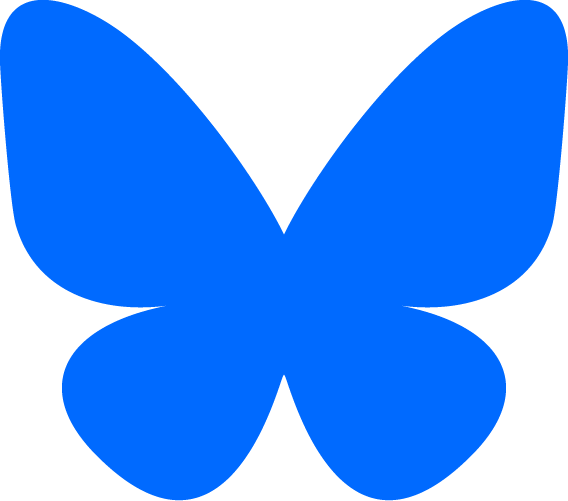Minnesota Antlions, Lacewings,
and Allies

Order Neuroptera
Neuroptera is an order of insects that includes antlions, owlflies, dusty wings, lacewings, and mantidflies. They are characterized by soft bodies; four membraneous wings; forewings and hindwings about the same size and shape; no abdominal sensory organs (cerci); mouthparts optimized for chewing; and development through four distinct stages (complete metamorphosis). The larvae have long, sickle-shaped mandibles adapted for piercing a prey’s body and sucking out the juices.
The classification of Neuroptera is not completely resolved. Until recently, the order Neuroptera included alderflies, dobsonflies, fishflies, and snakeflies. These are now treated as three separate orders. There are 37 families currently recognized, 14 of which are known from fossil records only. At least 7 families are found in Minnesota. There are 4,670 surviving species worldwide. Depending on the source, there are 338 (BugGuide.net), 353 (CCESR), or about 400 (Species catalog of the Neuroptera, Megaloptera, and Raphidioptera of America North of Mexico; Penny N.D., Adams P.A., Stange L.A. 1997) species in North America north of Mexico. There are at least 48 species in Minnesota.
Recent Additions

Brown wasp mantidfly (Climaciella brunnea) is a large wasp mimic. It occurs across the United States, in adjacent Canadian provinces, and in Mexico and Central America. It is widespread but considered scarce.
With its mantid-like front legs, wasp mantidfly looks similar to a praying mantis, but it is not even closely related. This is an example of convergent evolution, where unrelated organisms, adapting to similar environments, independently evolve similar characteristics. It also looks similar to a paper wasp. This is an example of Batesian mimicry, making it look like another species that is unpalatable or dangerous to potential predators.
Brown wasp mantidflies can be found on flowers where they wait on and ambush small insects.
Adults emerge in late May through October. Males live less than a week, females up to a month. They can be found on flowers where they wait on and ambush small insects.
During her time the female lays up to several thousand eggs. The small white eggs have short stalks and are attached to the underside of plant leaves. After an egg hatches the larva waits for and then attaches itself to a passing wolf spider. When the female wolf spider begins making an egg sac, the mantid larva crawls off the spider and onto the sac. It then gets wrapped up as the egg sac is completed and feeds on the spider eggs inside.

Common green lacewing (Chrysoperla carnea group) is a very common, medium-sized, net-winged insect. It occurs in Europe, Asia, North Africa, and North and South America. True to its common name, it is the most common green lacewing (family Chrysopidae).
Larvae are alligator-like in appearance. They have long, sickle-shaped mandibles and well-developed legs which allow them to move quickly. They are predacious, feeding mostly on aphids but also on many other insect adults, larvae, and eggs.
Adults have a long, slender, pale green body, long antennae, gold or copper-colored eyes, and transparent wings with a network of pale green veins. They are not predacious, feeding on flower nectar and pollen and on aphid honeydew. They are active at night and are attracted to lights. They may emit an unpleasant odor when handled.
Other Recent Additions
This list includes only antlions, owlflies, dusty wings, lacewings, and mantidflies that have been recorded in Minnesota, but not all of the antlions, owlflies, dusty wings, lacewings, and mantidflies found in Minnesota.
| Profile | Photo | Video | |||
|---|---|---|---|---|---|
antique brown lacewing (Micromus subanticus) |
|
||||
bellied antlion (Brachynemurus abdominalis) |
|||||
black-horned green lacewing (Chrysopa nigricornis) |
|||||
brown lacewings (Family Hemerobiidae) |
|||||
brown lacewings (Micromus spp.) |
|||||
cloudy antlion (Brachynemurus nebulosus) |
|||||
dustywing (Coniopteryx vicina) |
|||||
dustywing (Conwentzia hageni) |
|||||
dustywing (Malacomyza westwoodi) |
|||||
four-spotted green lacewing (Chrysopa quadripunctata) |
|||||
four-spotted santisfly (Dicromantispa interrupta) |
|||||
giant lacewing (Polystoechotes punctata) |
|||||
humulin brown lacewing (Hemerobius humulinus) |
|||||
immaculate antlion (Myrmeleon immaculatus) |
|||||
lacewings and allies (Suborder Hemerobiiformia) |
|||||
long-tailed antlion (Brachynemurus signatus) |
|||||
long-tailed antlion (Scotoleon nigrilabris) |
|||||
marked brown lacewing (Hemerobius stigma) |
|||||
posterior brown lacewing (Micromus posticus) |
|||||
red-lipped lacewing (Chrysoperla rufilabris) |
|||||
Say’s mantidfly (Dicromantispa sayi) |
|||||
Signoret’s green lacewing (Meleoma signoretti) |
|||||
spongillafly (Climacia areolaris) |
|||||
spotted-winged antlion (Dendroleon obsoletus) |
|||||
stripe-horned green lacewing (Ceraeochrysa lineaticornis) |
|||||
x-marked green lacewing (Chrysopa chi) |
Brachynemurus abdominalis (bellied antlion)
Brachynemurus nebulosus (cloudy antlion)
Brachynemurus signatus (long-tailed antlion)
Ceraeochrysa lineaticornis (stripe-horned green lacewing)
Chrysopa chi (x-marked green lacewing)
Chrysopa nigricornis (black-horned green lacewing)
Chrysopa oculata (golden-eyed lacewing)
Chrysopa quadripunctata (four-spotted green lacewing)
Chrysopa spp. (stink lacewings)
Chrysoperla carnea group (common green lacewing)
Chrysoperla plorabunda (weeping green lacewing)
Chrysoperla rufilabris (red-lipped lacewing)
Climacia areolaris (spongillafly)
Climaciella brunnea (brown wasp mantidfly)
Coniopteryx vicina (dustywing)
Conwentzia hageni (dustywing)
Dendroleon obsoletus (spotted-winged antlion)
Dicromantispa interrupta (four-spotted santisfly)
Dicromantispa sayi (Say’s mantidfly)
Hemerobiiformia (lacewings and allies)
Hemerobius humulinus (humulin brown lacewing)
Hemerobius stigma (marked brown lacewing)
Malacomyza westwoodi (dustywing)
Meleoma signoretti (Signoret’s green lacewing)
Micromus posticus (posterior brown lacewing)
Micromus spp. (brown lacewings)
Micromus subanticus (antique brown lacewing)
Myrmeleon immaculatus (immaculate antlion)
Polystoechotes punctata (giant lacewing)
Scotoleon nigrilabris (long-tailed antlion)
No Species Page Yet?
If you do not see a linked page for a species in the list at left you can still upload a photo or video or report a sighting for that species. Click on one of the buttons below and type in the common name and/or scientific name of the species in your photo, video, or sighting. A new page will be created for that species featuring your contribution.
These buttons not working for you?
Simply email us at info@MinnesotaSeasons.com.




_01it.jpg)





